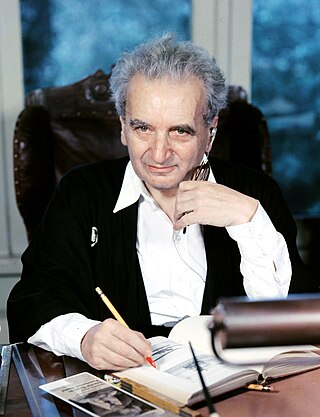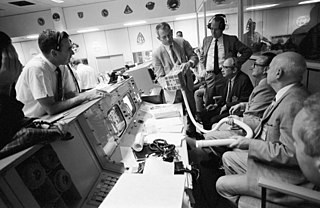
Theodore von Kármán, was a Hungarian-American mathematician, aerospace engineer, and physicist who worked in aeronautics and astronautics. He was responsible for crucial advances in aerodynamics characterizing supersonic and hypersonic airflow. The human-defined threshold of outer space is named the "Kármán line" in recognition of his work. Kármán is regarded as an outstanding aerodynamic theoretician of the 20th century.
Aeroacoustics is a branch of acoustics that studies noise generation via either turbulent fluid motion or aerodynamic forces interacting with surfaces. Noise generation can also be associated with periodically varying flows. A notable example of this phenomenon is the Aeolian tones produced by wind blowing over fixed objects.
Parviz Moin is a fluid dynamicist. He is the Franklin P. and Caroline M. Johnson Professor of Mechanical Engineering at Stanford University. Moin has been listed as an ISI Highly Cited author in engineering.
Computational aeroacoustics is a branch of aeroacoustics that aims to analyze the generation of noise by turbulent flows through numerical methods.

Roddam Narasimha FRS was an Indian aerospace scientist and fluid dynamicist. He was a professor of Aerospace Engineering at the Indian Institute of Science (1962–1999), director of the National Aerospace Laboratories (1984–1993) and the chairman of the Engineering Mechanics Unit at Jawaharlal Nehru Centre for Advanced Scientific Research. He was the DST Year-of-Science Chair Professor at JNCASR and concurrently held the Pratt & Whitney Chair in Science and Engineering at the University of Hyderabad. Narasimha was awarded the Padma Vibhushan, India's second-highest civilian award, in 2013. for his contributions to advance India's aerospace technology.

John "Shôn" Eirwyn Ffowcs Williams (1935–2020) was Emeritus Rank Professor of Engineering at the University of Cambridge and a former Master of Emmanuel College, Cambridge (1996–2002). He may be best known for his contributions to aeroacoustics, in particular for his work on Concorde. Together with one of his students, David Hawkings, he introduced the far-field integration method in computational aeroacoustics based on Lighthill's acoustic analogy, known as the Ffowcs Williams–Hawkings analogy.
In aeroacoustics, jet noise is the field that focuses on the noise generation caused by high-velocity jets and the turbulent eddies generated by shearing flow. Such noise is known as broadband noise and extends well beyond the range of human hearing. Jet noise is also responsible for some of the loudest sounds ever produced by mankind.

Aerospace engineering is the primary field of engineering concerned with the development of aircraft and spacecraft. It has two major and overlapping branches: aeronautical engineering and astronautical engineering. Avionics engineering is similar, but deals with the electronics side of aerospace engineering.
John Leask Lumley was an American fluid dynamicist and a professor at Cornell University. He is widely known for his research in turbulence and is the coauthor of A First Course in Turbulence along with Hendrik Tennekes.
Mohammed Yousuff Hussaini is an Indian born American applied mathematician. He is the Sir James Lighthill Professor of Mathematics and Computational Science & Engineering at the Florida State University, United States. Hussaini is also the holder of the TMC Eminent Scholar Chair in High Performance Computing at FSU. He is widely known for his research in scientific computation, particularly in the field of computational fluid dynamics (CFD) and Control and optimization. Hussaini co-authored the popular book Spectral Methods in Fluid Dynamics with Claudio Canuto, Alfio Quarteroni, and Thomas Zang. He is the editor-in-chief of the journal Theoretical and Computational Fluid Dynamics.

Dimitris Drikakis, PhD, FRAeS, CEng, is a Greek-British applied scientist, engineer and university professor. His research is multidisciplinary. It covers fluid dynamics, computational fluid dynamics, acoustics, heat transfer, computational science from molecular to macro scale, materials, machine learning, and emerging technologies. He has applied his research to diverse fields such as Aerospace & Defence, Biomedical, and Energy and Environment Sectors. He received The William Penney Fellowship Award by the Atomic Weapons Establishment to recognise his contributions to compressible fluid dynamics. He was also the winner of NEF's Innovator of the Year Award by the UK's Institute of Innovation and Knowledge Exchange for a new generation carbon capture nanotechnology that uses carbon nanotubes for filtering out carbon dioxide and other gases.
Gadicharla V.R. Rao , D.Sc. was an American aerospace engineer of Indian origin who worked in the jet engine and rocket propulsion fields. Rao worked for General Electric in their Gas Turbine Division department and was a research scientist at Marquardt Aircraft, before working for Rocketdyne, where he designed the optimum thrust nozzle. Often referred to as the "Rao's nozzle", it is part of the standard design for rocket engines. The Rao Nozzle is used currently in rocket, missile, and satellite control systems worldwide. It is taught in universities that offer Aerospace Engineering, including Massachusetts Institute of Technology (MIT), California Institute of Technology (Caltech), and Georgia Institute of Technology.
Mohammad (‘Mo’) Samimy is the John B. Nordholt Professor of Mechanical and Aerospace Engineering and the founding director of the Aerospace Research Center (ARC) at Ohio State University (OSU). He has made significant contributions towards the understanding of the physics and control of high-speed and high Reynolds number turbulent shear flows and jet aeroacoustics.
Sébastien Candel is a French physicist, Emeritus Professor of École Centrale Paris.
Mujeeb R. Malik is a Pakistani born American aerospace engineer serving as Senior Aerodynamicist at NASA Langley Research Center. He is known for his research in boundary layer stability, laminar-turbulent transition, computational methods and aerodynamic simulations. He was the architect of CFD Vision 2030, a NASA-sponsored study to advance the state-of-the-art of computational fluid dynamics (CFD) by exploiting high performance computing and modern validation experiments.

Charles Meneveau is a French-Chilean born American fluid dynamicist, known for his work on turbulence, including turbulence modeling and computational fluid dynamics.
Leslie S. G. Kovasznay was a Hungarian-American engineer, known as one of the world's leading experts in turbulent flow research.
James Eugene "Gene" Broadwell was an American aeronautical engineer, known for the Broadwell model. The model consists of a set of differential equations, describing the structure of a shock wave in a simple discrete velocity gas.

Lyle Norman Long is an academic, and computational scientist. He is a Professor Emeritus of Computational Science, Mathematics, and Engineering at The Pennsylvania State University, and is most known for developing algorithms and software for mathematical models, including neural networks, and robotics. His research has been focused in the fields of computational science, computational neuroscience, cognitive robotics, parallel computing, and software engineering.

Hassan M. Nagib is a mechanical engineer, aerospace engineer, and academic. He is the John T. Rettaliata Professor of Mechanical and Aerospace Engineering at the Illinois Institute of Technology and was also the Founding Director of the institute's Fluid Dynamics Research Center.








